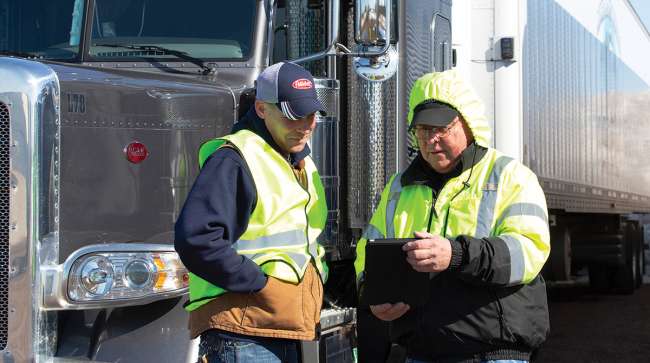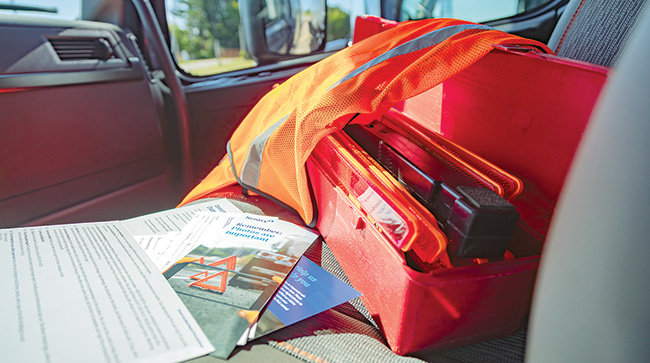Special to Transport Topics
As Nuclear Verdicts Drive Up Costs, Focus Is on Safety, Data

[Stay on top of transportation news: Get TTNews in your inbox.]
Escalating insurance costs have become a severe financial headwind for trucking companies in an industry already known for tight profit margins. “We first started seeing it five or six years ago,” said Ken Johnson, CEO of Farmington, N.Y.-based transportation provider Leonard’s Express. “We had a good year and were expecting our insurance cost to stay flat or drop, and it doubled. We were taken aback.”
A leading factor driving up trucking insurance expenses are nuclear verdicts — jury awards upward of $10 million in cases involving truck crashes. Plaintiff attorneys play on jurors’ emotions and convince them that transportation companies are inherently dangerous, regardless of the facts. Trucking companies and insurance providers generally consider these awards to be grossly disproportionate to the case damages.
Nuclear verdicts started ramping up about 10 years ago, but these high-dollar cases aren’t the only ones contributing to trucking’s challenging insurance market.
“It’s not necessarily just 20 or 30 headline cases, but the tens of thousands of smaller cases that are lifted up by the specter of these large verdicts,” said Chris Homewood, senior vice president and head of commercial auto at Hudson Insurance Group. “The insurance market hasn’t made money in 11 years. It’s paying out more in losses and expenses than it’s taking in in premiums.”

How much impact does driver pay have in hiring drivers? And what else can fleets do to recruit and retain quality talent? Hear a snippet from DriverReach founder and CEO Jeremy Reymer, above, and listen to the full program at RoadSigns.TTNews.com.
Apart from litigation, other factors also are driving the recent increase in insurance costs.
“There has been a lack of proper pricing from the insurance markets over the past decade. They haven’t priced their product where it allows them to make money,” said Don Arrowood, senior vice president at insurance broker Lockton Cos. “For at least 24 months, there has been a strong change in the insurance marketplace with pressure for insurance companies to reprice, or ‘right size,’ the pricing.”
Plus, each insurance claim is larger now than it was a decade ago.
“The average cost of a claim is increasing 5, 6 and 10%. Rates need to go up just to stay where we are. To get back to profitability, rates will have to increase,” said Nick Saeger, assistant vice president of transportation products, pricing and underwriting at Sentry Insurance.
Insurers report that excess, or secondary, insurance especially has taken a hit. They also increasingly implement more stringent caps on coverage limits.
Conditions have prompted some insurance providers to exit the commercial transportation market altogether. With fewer players in the insurance market, prices have risen and carriers have been left scrambling to find coverage.
“For that subset that does get quoted, the companies are careful about the amount of the balance sheet they commit to any one client,” said Dan Cook, principal and practice leader at insurance broker TrueNorth.

Cook
Looking ahead, more financial strain could be coming for some carriers after the U.S. House of Representatives recently passed a highway reauthorization bill that includes a provision to hike the minimum liability insurance coverage for motor carriers to $2 million, more than double the current $750,000.
But fleets don’t have to sit idly by and accept surging insurance costs, experts said. There are measures that can ease the financial burden, and even small tweaks here and there add up over time.
Building a Culture of Safety
Establishing an effective safety program might seem like an obvious solution, but it really does make a difference in rates, insurers said. The state of the market has made coverage providers pickier about which clients they take on, and a strong safety culture is imperative.
One way to boost safety is by deploying modern technologies such as telematics, collision mitigation, lane-change sensors, automated steering assistance and onboard cameras. In-cab cameras, for example, can provide liability protection. The technology corroborates a solid safety record, which could result in lower premiums.
But just adding the technology is not enough.
A fleet’s safety culture must run deeper than its devices. It starts with its people, insurers said.
“The big thing we’re looking for is not just the presence of technology but how it’s being used in the overall culture of the organization,” said Jeff Davis, vice president of safety at Napa River Insurance Services. “We focus on operations and personnel to see how involved they are when they deal with drivers every single day.”
The most successful safety cultures exhibit engagement at all levels of the organization, especially with frontline workers. For example, daily involvement from dispatchers or driver managers — who talk to drivers multiple times a day — can identify safety gaps to address, including driver fatigue or overloaded schedules.
“If you have all the technology in the world but don’t manage it consistently or properly, that becomes a hole in safety,” said Homewood of Hudson Insurance Group.
Frequent, ongoing training on safety practices and technologies is something insurers look for when assessing a fleet.
“We never advocate for just firing drivers involved in accidents. But rather, try to find ways to educate, train and save drivers and make them better before they have a big accident. That’s critical,” Davis said.
Even in an extremely tight labor market, it’s important for fleets to stand firm on their hiring standards.
“There are times when the driver market is really tough and the temptation is to relax standards and open the labor pool a little more,” Davis said. “We see it over and over again when companies do that, that there is greater accident frequency, greater turnover, greater cost of risk. It actually costs the motor carriers in the end.”
Data-Driven Insurance
Insurance companies typically do not offer fleets upfront discounts for using safety-enhancing technologies. However, the technologies indirectly keep insurance costs in check by reducing incidents, and therefore premiums.
That being said, Arrowood of Lockton Cos. points out that “there are a number of insurance companies subsidizing technology investment installations or monthly costs, especially cameras. … Insurance companies strongly believe that improving in-cab behavior is a game changer.”
Insurers use considerable amounts of data to determine fleets’ coverage and costs. The companies often incentivize fleets to voluntarily submit in-cab data gathered through telematics or cameras.
“Underwriting is much more rigorous now. There is a great deal more data available,” TrueNorth’s Cook said. “Underwriters are considering things that they didn’t consider in the past, and they make more complete and accurate decisions than 25 years ago.”
Robust, authentic data is so important to insurance rate calculations that onboard technology is not always optional. Some insurers mandate that fleets turn over data gathered via technology or even provide telematics log-in passwords so they can directly access the granular data. Cook predicts more insurers will do this in the future.
“What were the weather conditions at the time? Was there construction? What were the traffic patterns? … That is available in real time today, and progressive underwriters gather all that data,” Cook said. “You’re able to match rate to risk better when you take that into consideration … and that will be a common rating practice in the not-too-distant coming years.”
Those telematics-driven metrics also are the backbone for usage-based, or pay-as-you-go, insurance. More usage-based options are emerging for commercial trucking. They provide a certain amount of flexibility for users to pick different options — even one-trip coverage — and in some cases that can save money.

Driver training and hiring practices remain paramount, even in a tight labor market. (Sentry Insurance)
Some usage-based insurance is offered through traditional agencies, but many are app-based or web-based. The platforms typically allow users to explore options, receive quotes and book different coverage levels on their own.
A number of these products especially target smaller trucking operations. For instance, Cover Whale touts itself as providing “coverage options to owner-operators that were too difficult for conventional insurance companies to write.”
Some fleets investigate these platforms to avoid insurance broker fees.
Risky Business
Fleets feeling the squeeze cannot simply forgo insurance altogether due to government regulations and customer requirements, but their buying habits definitely are changing, insurers said.
“Motor carriers, in general, across the country have reduced the amount of insurance they buy by mid-single to double-digit percentages,” Arrowood said.
This sometimes occurs because fleets stop purchasing as much insurance coverage when they can’t afford it. But in other instances, it is a strategic move. Insurers overwhelmingly advise fleets to take on more risk, or higher deductibles, to reduce costs.
“If a motor carrier takes on more risk because of improved loss control or safety technology, every dollar they save goes right to the bottom line,” Arrowood said. “For companies that are willing to bet on themselves, that’s a great way to reduce overall costs.”

Arrowood
Generally, large carriers are more fit for higher deductibles.
“We deal with some small carriers, including one-truck operations. I think it hits them proportionately more. Large carriers tend to take on a larger piece of risk themselves — whether that’s a larger deductible or they’re self-insured,” said Johnson of Leonard’s Express.
Fleets and insurers alike are getting creative with different coverage plans to manage costs and risk. Self-insurance is becoming a more popular option. And insurers encourage carriers to investigate whether they would receive better coverage and rates by splitting their business among multiple providers.
“We used to have larger policies and a single carrier. Now we need several carriers just to get to where we’re comfortable,” Johnson said. “It was driven by our insurance carrier, not by us.”
Don’t be afraid to shop around and to re-evaluate insurance needs as the market and carrier operations change, and seek agents who are well-versed specifically in transportation insurance, experts said.
“The cheapest price is not always the best price. You need a true professional who knows the nuances of handling trucking claims and safety,” said Larry Harlow, associate director of claims at Sentry Insurance.
Specialized insurance agents can have hidden financial benefits. They often provide additional services that increase a fleet’s return on investment.
“Working with a specialist is my biggest tip, not just because they have access to the best markets … but a secondary benefit is they often can come [on-site] and help you. A lot of agencies have resources like safety teams. That’s a lot of value added to a trucking company to have resources that come in and offer another set of eyes,” said Dan Clements, director of sales at Sentry Insurance.
At an industrywide level, insurers said trucking companies can help address the high cost of insurance by getting involved in associations and advocating for state-level laws that impact the court systems and reduce the instance of nuclear verdicts.
“I can’t overstate this: There has to be a groundswell of state-level tort reform advocacy by and on behalf of the trucking industry,” Arrowood said.
Want more news? Listen to today's daily briefing below or go here for more info:




